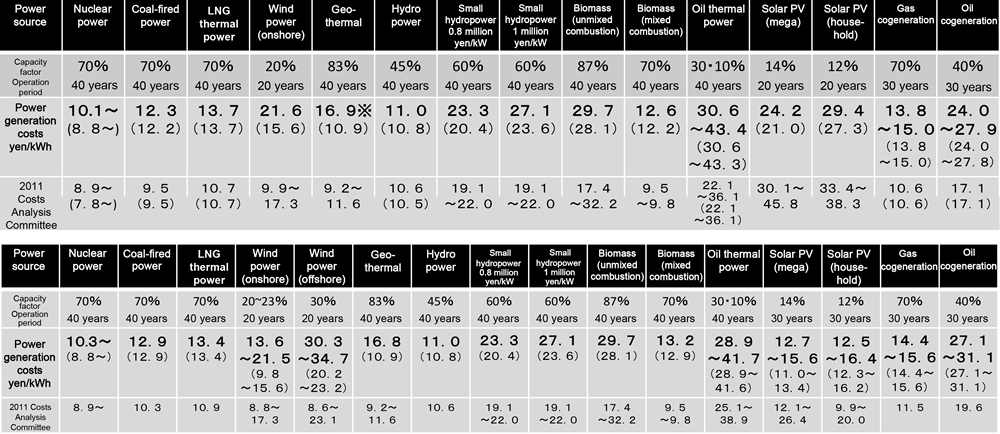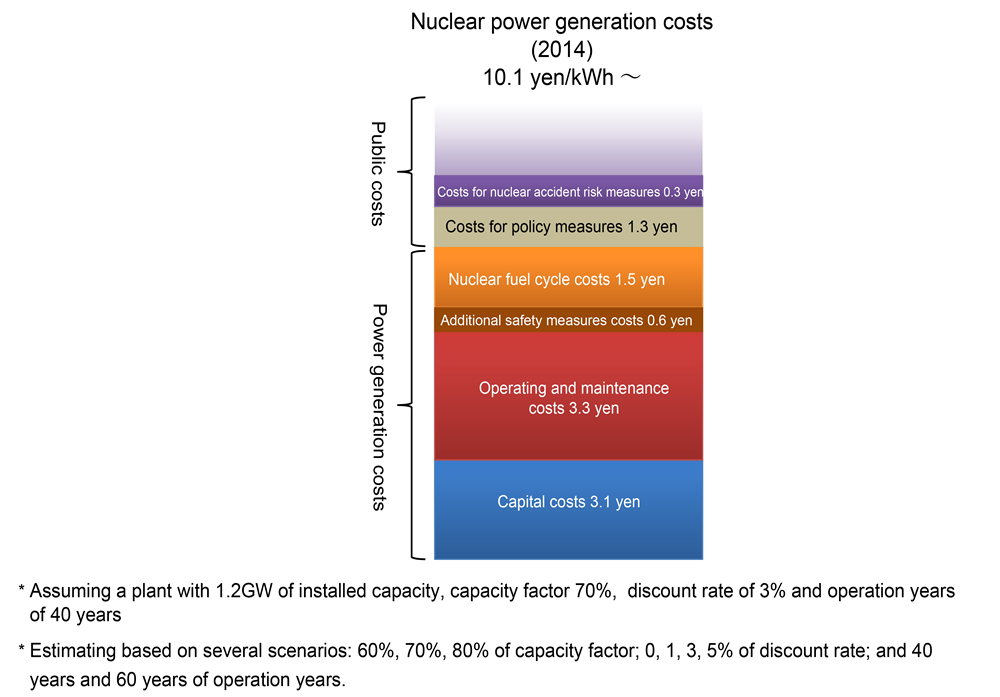Renewables Update
Promoting nuclear power rather than renewables?
Information publicized by the Japanese Government
Masaya Ishida,Manager, Renewable Energy Business Group, Renewable Energy Institute
In the midst of reviewing the Basic Energy Plan, which determines the nation’s energy policy direction, the Ministry of Economy, Trade and Industry (METI) opened a web page providing related information to the public. In the section titled “Special Contents”, articles on electricity and energy are continuously published. However, the contents of such articles are often contrary to the two important policies stipulated in the current Basic Energy Plan – “Renewable energy shall be introduced to the maximum” and “Dependency on nuclear power shall be lowered to the extent possible” The arguments there are frequently misleading the people concerning nuclear power and renewables (renewable energy).
“Nuclear power continues to have advantages”
A typical example is an article that appeared on 31 October titled “Examining the Costs of Nuclear Power”. The following is a brief introduction to its content:
This article cites the estimated costs of nuclear power generation, the main topic of this article, which was calculated in 2015 by a working group of experts (Figure 1). Assuming very large facilities with an output of 1.2 GW, the costs were estimated to be 10.1 yen/kWh or more.

As to the costs for nuclear accident risk measures, only the minimum costs were incorporated in the estimate with an implication that they may increase in the future. That is why power generation costs were shown by adding “~.” The nuclear accident costs of the Fukushima-Daiichi Nuclear Power Plant was assumed in 2015 to be 12.2 trillion yen, but in this generation cost calculation, the nuclear accident cost was adjusted to 9.1 trillion yen, based on the output scale and the like (Figure 2).

Source: The Power Generation Cost Verification Working Group (May 2015)
In December 2016, however, it became clear that nuclear accident costs of Fukushima would expand to 21.5 trillion yen in total, with the possibility of further increase in the future. According to the estimation of the Working Group, every time nuclear accident costs increase by 1 trillion yen, nuclear generation costs rise by 0.04 yen/kWh.
In addition, the costs that will emerged in the future are estimated low — disposal costs of high level wastes are estimated at only 0.04 yen/kWh, for instance. It is impossible to make appropriate estimation of necessary costs in a situation where even candidate disposal sites are not yet determined. Massive amount of wastes are required to be monitored for 300 years after burying them at a depth of more than 300 m underground. We can only be sure that enormous costs will be incurred.
Thus, the power generation costs of nuclear power are gradually accumulating. Still, METI stresses to the public that, “power generation costs of nuclear power will not be higher than those of thermal power or renewable energy, and there is no change to nuclear power having advantages with generation costs.”
Examples of nuclear generation costs losing advantages can be seen notably in new construction projects in the US and Europe. Construction costs of the Hinkley Point C Nuclear Power Station (1.63 GW × two reactors), now under construction in the UK, swelled to 2.94 trillion yen (19.6 billion pounds) because of the changes in design and delays in schedule. Construction costs per kW have reached 900,000 yen. It is 2.4-fold the costs of 370,000 yen/kW that the Working Group in Japan had estimated for the model plant. Converting to power generation costs, it is equivalent to an increase of 4.4 yen/kWh.
Even if specifications of power generation facilities are different, it is clear that nuclear power plants cannot be constructed with competitive costs. In the US, construction costs of Units 3 and 4 of the Vogtle Nuclear Power plant (1.12 GW × two reactors), now under construction using the Westinghouse reactors of Toshiba Group, increased to 2.3 trillion yen (21 billion dollars), costing more than 1 million yen/kW. It has now become common sense throughout the world that nuclear power generation costs are no longer low.
Pointing out problems of renewables, not the advantages
The attitude of METI towards renewables is also highly questionable. In the “Special Contents” dated 31 October, the space for constructing power plants is compared between the cases of nuclear power and solar PV/wind power for the purpose of demonstrating the advantage of nuclear power. To obtain an annual generation output of a nuclear power plant with a capacity of 1 GW, the article explained that solar PV requires 58 km² and wind 214 km², which is respectively about 100-fold and 350-fold that of nuclear power. The article claims, “Compared to nuclear power generation and thermal power generation, renewables require vast areas of land.”
However, solar PV can be installed on rooftops without occupying extra land. Even in the case of installing large windmills for wind power generation, a 6 by 6 meter area is sufficient for the foundation, while the surrounding area can be used for other purposes. The large space estimated by METI is not necessary. Actually, there are many cases of solar PV and wind farms constructed on agricultural land. Unlike nuclear power generation, coexistence with agriculture or forestry is possible.
One of the serious problems of Japan’s electric power systems revealed in the Fukushima accident was the vulnerability of energy security caused by the concentration of large-scale power plants in specific areas. We must not forget that the planned power outages were implemented throughout the Kanto region as a result of supply shortages during the summer after the accident. In contrast, the impact of an operation suspension of one renewable energy facility will be small, since generation facilities of renewable energy can be constructed diversely in various places throughout the country.
METI’s “Special Contents” does not explain the advantages of renewables, including the low environmental load compared to thermal or nuclear power generation, and the virtuous economic cycle achieved through constructions and operations of power plants conducted in various local areas, and other elements that are enabling renewables to expand all through the world. The articles point out the increased cost burden in the Feed-in Tariff system as a problem. However, the cost actually creates new revenues and employment throughout Japan. It greatly differs from nuclear power generation by which only specific towns enjoy benefits.
METI has just finished a series of expert meetings from May to July to examine policy issues toward massive introduction of renewables. Being at the stage of implementing new policies, what is the good of emphasizing to the public the problems of renewables rather than their advantages? If Japan continues to rely on the conventional power systems of thermal and nuclear power generation, we will be left behind in the global trend.
Amid the situation where various countries are moving toward a carbon-free society, Japan is required to transform to a new industrial structure with the use of regional renewables. For METI, which should assume such policies, this is no time to publish information that is inconsistent with the global trend.
"Special Contents" of METI:
“Examining the Costs of Nuclear Power” (31 October 2017)






